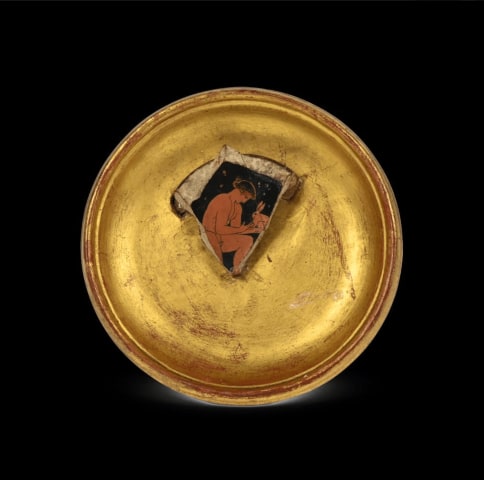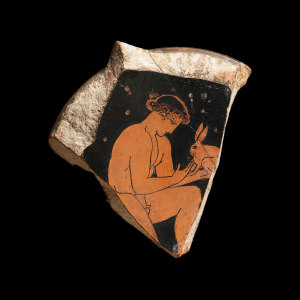Made up of three separate elements re-attached with a corresponding fine hairline cracks visible on close inspection. The first running from the hind leg of the hare through its body and through the hair of the youth to the upper edge. A further corresponding hairline crack running from the extreme left edge through the base of the youth's hair and head above his eye and meeting the first crack on the forehead.
A label on the reverse of the old mount inscribed in the hand of David Robert Alexander Lindsay, 28th Earl of Crawford and 11th Earl of Balcarres (1900-1975) or his wife reads: "Given us by Glyn Philpot, to whom it was given by 1st [sic] Lord Esher". A second label, signed, inscribed and dated by J.D.Beazley reads: 'Part of a stemless cup circa 430 BC, an exquisite work by the Eretria painter, one of the most charming artists of the free style. J.D.Beazley 14.7.55"
Beazley named this artist the 'Eretria Painter' after the findspot of the namesake vase. While he was an influential cup painter, some of his finest work appears on small vases of various shapes. He was a supremely skilled miniaturist, as evidenced by the present fragment which Beazely remarked as being an 'exquisite' example. The subject of a youth holding a hare derives from a common courting scene between an erastēs and erōmenos, wherein the former is shown (often leaning on a knotted staff) extending a hare in a gesture of affection toward the erōmenos (the younger of the two), seeking his favour. The present vase shows a less common variant of this courtship, where the erōmenos has received the gift willingly and is admiring it. In this context, the hare symbolizes an erotic relationship.
Glyn Philpot's friendship with Reginald Baliol Brett, 2nd Viscount Esher (1852-1930) is well known. Philpot's portrait of Esher (sold Christie's, London, 15th Dec 2022, lot 152) initiated a friendship between the two resulting in another, less formal, portrait commissioned and then exhibited at the Royal Academy in 1927. From this friendship and the dates, it is likely that the label on the reverse written by Lindsay may actually refer to 2nd Viscount Esher - and not his father. One cannot ignore the significance of the imagery on this fragment; Brett's notorious extra-marital homosexual tendencies, and Philpot's position as an openly gay man, make it most likely that this fragment was given to Philpot by Brett as a form of acknowledgement for an intimate relationship between the men. Brett was 32 years Philpot's senior, making the former the erastēs, and the latter the erōmenos.
Provenance
William Baliol Brett, 1st Viscount Esher, (1855-1899), UKReginald Baliol Brett, 2nd Viscount Esher, (1852-1930), UK
Glyn Warren Philpot (1884-1937) London, UK; gifted by the above c.1927
David Robert Alexander Lindsay, 28th Earl of Crawford and 11th Earl of Balcarres (1900-1975); gifted by the above
Hon Patrick Lindsay (1928-1986), UK; by descent from the aboveLady Amabel Mary Maud Lindsay (b.1935), UK; inherited from the above, her husband, in 1986
Private collection, UK; gifted from the above, his mother
Literature
For the subject compare a Hydria, attributed to The Kleophrades Painter, c. 480 BC, Rome, Villa Giulia, Museo Nazionale Etrusco, and also a Neck Amphora, attributed to the Matsch Painter, c, 480 BC, Rome, Villa Giulia, Museo Nazionale Etrusco.For a similar subject by the Eretria painter, see the lid of a Pyxis in the Worcester Museum of Art, USA, depicting two Erotes pitting cocks and two Erotes with a hare.



